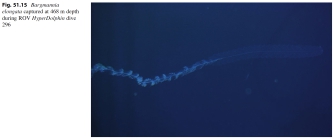WoRMS taxon details
Bargmannia elongata Totton, 1954
135506 (urn:lsid:marinespecies.org:taxname:135506)
accepted
Species
marine, fresh, terrestrial
recent only
Totton, A. K. (1954). Siphonophora of the Indian Ocean together with systematic and biological notes on related specimens from other oceans. <em>Discovery Rep.</em> 27: 1-162., available online at https://www.biodiversitylibrary.org/page/5611213
page(s): 69, txt-fig. 28 [details]
page(s): 69, txt-fig. 28 [details]
Type locality contained in Central North Atlantic
type locality contained in Central North Atlantic [details]
Distribution See also Dunn 2005 SEM budding study
Distribution cosmopolitan
Distribution See also Dunn 2005 SEM budding study [details]
Distribution cosmopolitan
Distribution cosmopolitan [details]
Schuchert, P. (2024). World Hydrozoa Database. Bargmannia elongata Totton, 1954. Accessed through: World Register of Marine Species at: https://www.marinespecies.org/aphia.php?p=taxdetails&id=135506 on 2024-07-26
Date
action
by
![]() The webpage text is licensed under a Creative Commons Attribution 4.0 License
The webpage text is licensed under a Creative Commons Attribution 4.0 License
original description
Totton, A. K. (1954). Siphonophora of the Indian Ocean together with systematic and biological notes on related specimens from other oceans. <em>Discovery Rep.</em> 27: 1-162., available online at https://www.biodiversitylibrary.org/page/5611213
page(s): 69, txt-fig. 28 [details]
context source (Deepsea) Pugh, P. R. (2013). Confirmed records of Siphonophorae found below 500 m depth. (personal database). [details]
context source (Hexacorallia) Fautin, Daphne G. (2013). Hexacorallians of the World. (look up in IMIS) [details]
additional source Pugh, P. R. & Gasca, R. (2009). Siphonophorae (Cnidaria) of the Gulf of Mexico. Pp. 395–402. In: Felder, D.L. and D.K. Camp (eds.), Gulf of Mexico–Origins, Waters, and Biota. <em>Biodiversity.</em> Texas A&M Press, College Station, Texas. [details]
additional source Liu, J.Y. [Ruiyu] (ed.). (2008). Checklist of marine biota of China seas. <em>China Science Press.</em> 1267 pp. (look up in IMIS) [details] Available for editors [request]
[request]
additional source Pugh, P. R. 1999. A review of the genus Bargmannia Totton, 1954 (Siphonophorae, Physonecta, Pyrostephidae). - Bulletin of the Natural History Museum Zoology Series 65: 51-72., available online at https://www.biodiversitylibrary.org/page/41009346
page(s): 53, figs 2-5 [details]
additional source Dunn, C.W. 2005. Complex colony-level organization of the deep-sea siphonophore Bargmannia elongata (Cnidaria, Hydrozoa) is directionally asymmetric and arises by the sub-division of pro-buds. Developmental Dynamics 234: 835-845., available online at https://doi.org/10.1002/dvdy.20483 [details]
ecology source Pugh, P. R. (1999). Siphonophorae. In South Atlantic Zooplankton I. Edited by D. Boltovskoy. <em>Backhuys Publishers, Leiden, The Netherlands.</em> 1-868. [details]
ecology source Pugh, P. R. 1999. A review of the genus Bargmannia Totton, 1954 (Siphonophorae, Physonecta, Pyrostephidae). - Bulletin of the Natural History Museum Zoology Series 65: 51-72., available online at https://www.biodiversitylibrary.org/page/41009346 [details]
ecology source Kirkpatrick, P.A.; Pugh, P.R. (1984). Siphonophores and velellids: keys and notes for the identification of the species. <i>Synopses of the British fauna (new series)</i>, 29. E.J. Brill/W. Backhuys: London, UK. ISBN 90-04-07470-8. vi, 154 pp. (look up in IMIS) [details]
page(s): 69, txt-fig. 28 [details]
context source (Deepsea) Pugh, P. R. (2013). Confirmed records of Siphonophorae found below 500 m depth. (personal database). [details]
context source (Hexacorallia) Fautin, Daphne G. (2013). Hexacorallians of the World. (look up in IMIS) [details]
additional source Pugh, P. R. & Gasca, R. (2009). Siphonophorae (Cnidaria) of the Gulf of Mexico. Pp. 395–402. In: Felder, D.L. and D.K. Camp (eds.), Gulf of Mexico–Origins, Waters, and Biota. <em>Biodiversity.</em> Texas A&M Press, College Station, Texas. [details]
additional source Liu, J.Y. [Ruiyu] (ed.). (2008). Checklist of marine biota of China seas. <em>China Science Press.</em> 1267 pp. (look up in IMIS) [details] Available for editors
additional source Pugh, P. R. 1999. A review of the genus Bargmannia Totton, 1954 (Siphonophorae, Physonecta, Pyrostephidae). - Bulletin of the Natural History Museum Zoology Series 65: 51-72., available online at https://www.biodiversitylibrary.org/page/41009346
page(s): 53, figs 2-5 [details]
additional source Dunn, C.W. 2005. Complex colony-level organization of the deep-sea siphonophore Bargmannia elongata (Cnidaria, Hydrozoa) is directionally asymmetric and arises by the sub-division of pro-buds. Developmental Dynamics 234: 835-845., available online at https://doi.org/10.1002/dvdy.20483 [details]
ecology source Pugh, P. R. (1999). Siphonophorae. In South Atlantic Zooplankton I. Edited by D. Boltovskoy. <em>Backhuys Publishers, Leiden, The Netherlands.</em> 1-868. [details]
ecology source Pugh, P. R. 1999. A review of the genus Bargmannia Totton, 1954 (Siphonophorae, Physonecta, Pyrostephidae). - Bulletin of the Natural History Museum Zoology Series 65: 51-72., available online at https://www.biodiversitylibrary.org/page/41009346 [details]
ecology source Kirkpatrick, P.A.; Pugh, P.R. (1984). Siphonophores and velellids: keys and notes for the identification of the species. <i>Synopses of the British fauna (new series)</i>, 29. E.J. Brill/W. Backhuys: London, UK. ISBN 90-04-07470-8. vi, 154 pp. (look up in IMIS) [details]
 Present
Present  Present in aphia/obis/gbif/idigbio
Present in aphia/obis/gbif/idigbio  Inaccurate
Inaccurate  Introduced: alien
Introduced: alien  Containing type locality
Containing type locality
From editor or global species database
Distribution See also Dunn 2005 SEM budding study [details]From other sources
Distribution cosmopolitan [details]Habitat epi-bathypelagic [details]
| Language | Name | |
|---|---|---|
| Japanese | ナガヘビクラゲ | [details] |


